Trevor Gale's Engineering Interests.
Latest update: 5th June, 2009.
It was here after moving to the Netherlands ('Holland')that I was given the
opportunity of working with the European Space Agencys' Technical Research
centre 'ESTEC' in Noordwijk, very near where I live now.
That proved to be the best step I could ever have taken, it has
provided me with steep challenges to overcome in some very different working
environments, including notably involvement in the GIOTTO mission to fly by
the comet Halley (it did so in 1986 and even survived to do further work) and
to take part in early European parabolic test-flights, in which during one
flight one experiences some 30 'parabolae', each one starting with 2G (twice
gravity, so twice your own weight!), then zero-G (as in space, weightless),
followed by another 2G phase and a return to 'normal' 1G until the start of
the next parabola. I'm not sure how many such flights I did, but it was
quite a lot and it was very hard work even though at the same time a very
satisfying feeling. I was one of the lucky ones in that I never got sick,
like in sea-sickness, something I have not experienced even when performing
work during the 2G phases.
As an indication of the period of zero-G and the before-and-after 2-G periods,
here's a shot of the accelerometer reading for one parabola:-
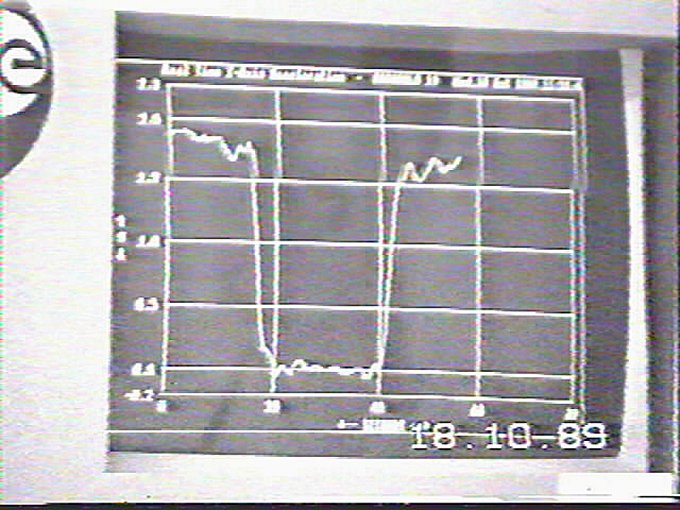
Some photographs of the flights follow here - and some short video clips which you may select by clicking on the links below:- Note the video clips are big files, some 3Mbytes, but with a reasonable connect that shouldn't be a problem.
For information, 'inject' means the injection into the zero-gravity phase,
and 'recovery' means the going back into 2-G after a parabola... First, a very important experiment of mine was into how to handle a smokers'
pipe in zero-G - (click here to view) that was
actually done in 'spare time' during one of the parabolae.
Then there's a clip of someones' effort at 'dancing' in zero-G
(click here to view this one) which again
was done in spare time.
Finally there's a cockpit intrument view(click here
to view it, in black-and-white) showing especially the rate of climb and
descent during one parabola (top right instrument).
Now some shots: first an example of how to get from one experiment to another in zero-G:-
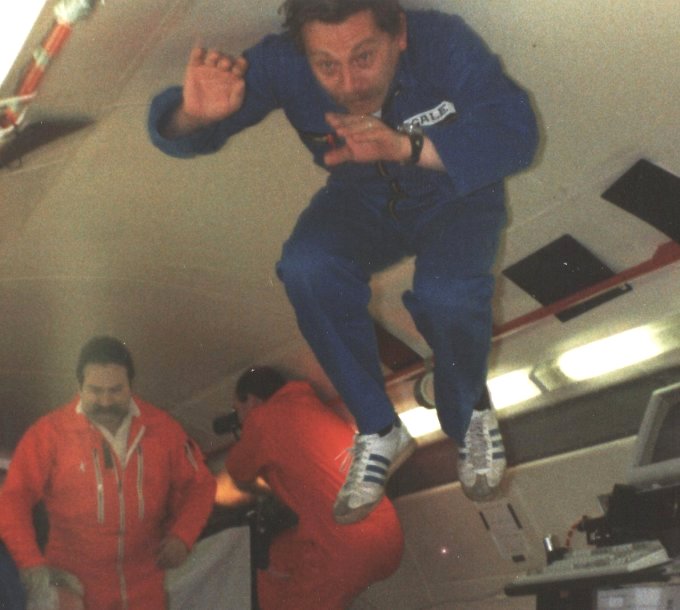
Now working in such a flight means 'catching a drink' now and again:-
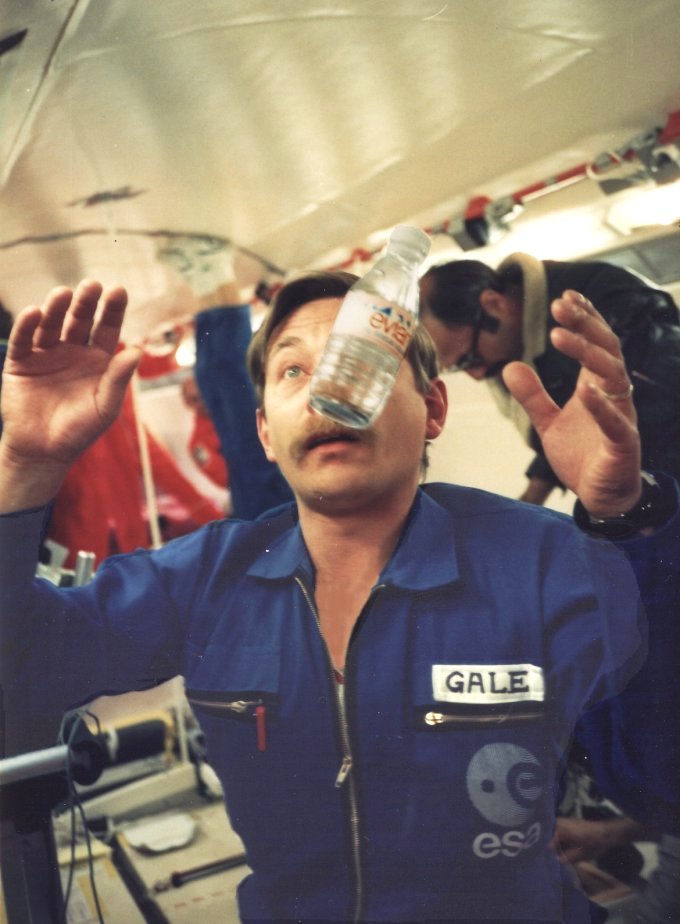
For the sake of science, sometimes I lent my services as a 'guinea-pig', and
here I'm being marked up not for a crash but for seing how certain movements
are made during zero-G efforts:-
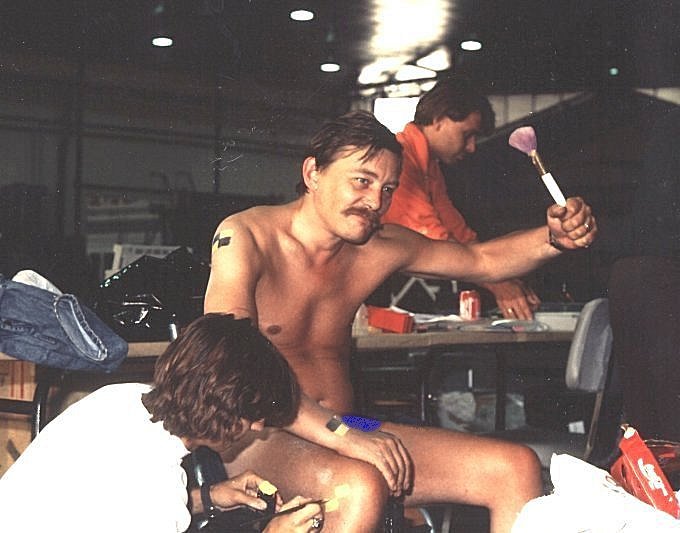
Of course, each and every experiment demands the participation of a small team working closely together, so here's the group for one of them:-
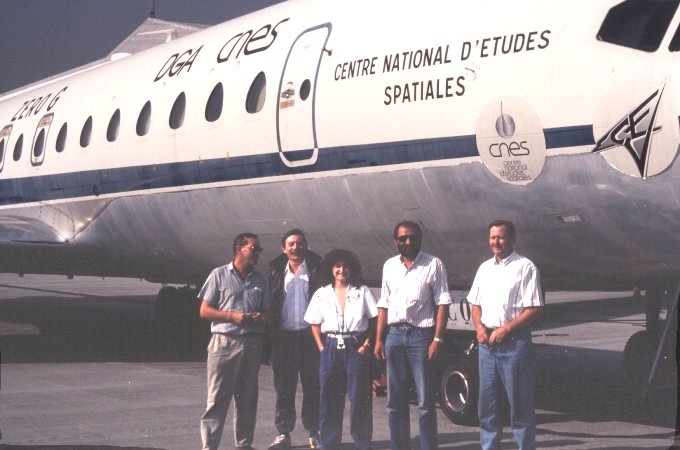
Here is a closer view of the team:-
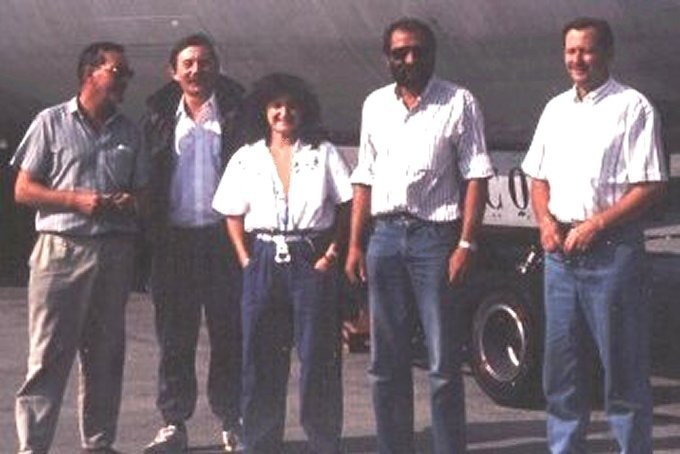
I have also been involved in making DAB measurements from a
simulated satellite platform, using an adapted helicopter, co-authoring a
feasibility study into the use of DAB from satellte in urban built-up areas
and in open, rural areas which may include those encountered in what we
tend to call 'the third world', or developing countries for applications such
as education and medical advice.
Although I made a career out of professional electronics, I am still actively
interested in radio electronics, especially receiver techniques, and I have
here at home my own electronics workshop where I am often to be found working
until strange hours - I mostly generate my best ideas (also for other interests)
between around 10:00PM to 02:30AM ! Below you can see firstly the entrance to
all my 'places':-
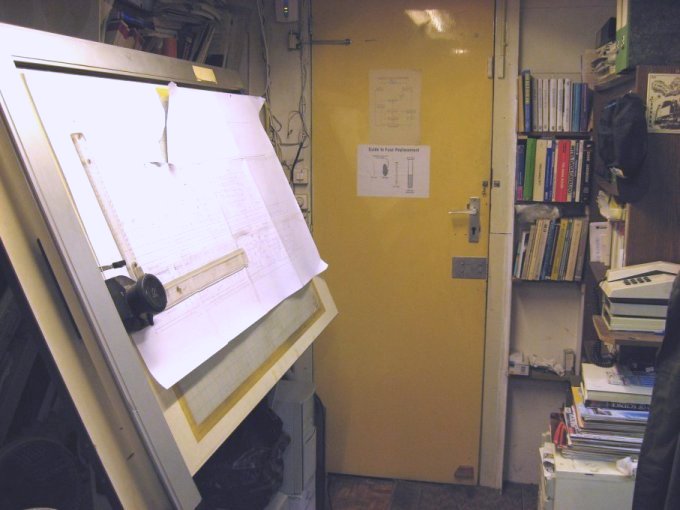
...and me at one of my workbenches in the workshop itself:-
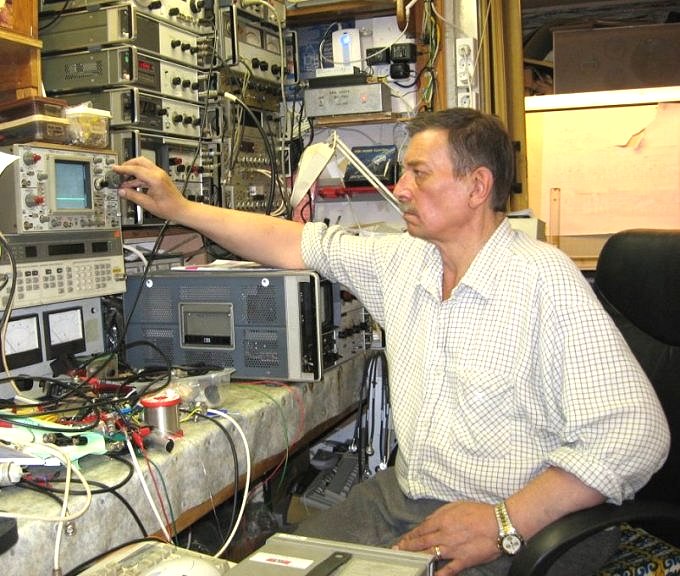
which was posed but you can get the general view or idea. Following are a
couple of other views of my workshop:-

and some of my equipment:-

I also like to be able to manufacture what I need for things like antennas,
and various couplings and so on, and to this end I also have a mechanical area
in my workshop which has an old Myford lathe which is much older than I am
and which I have re-furbished and made a lot of tooling for - you can see me
typicaly working at the lathe here:-
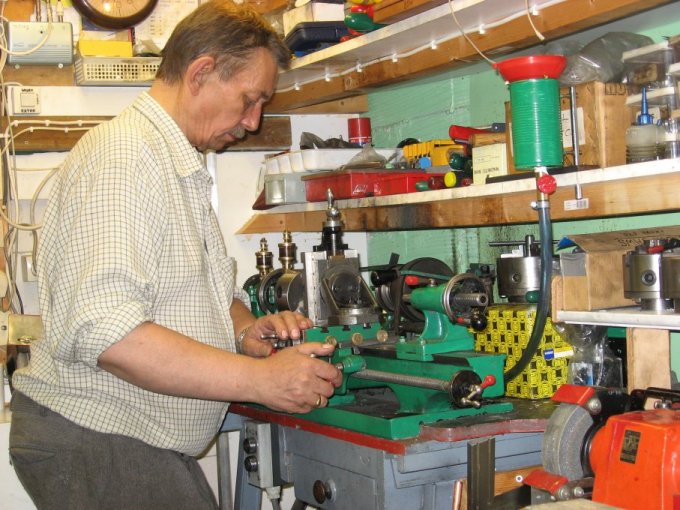
Below you can see the mess produced by
working cast-iron, in this case for a chuck backplate, so you can see it
does actually get used:-

In amongst there I also have the usual vertical bench drill, tool grinder,
and a lot of spares, metal stock of various types and sizes and screws etc.
The lathe itself you can see a (cleaner!) view of below:-
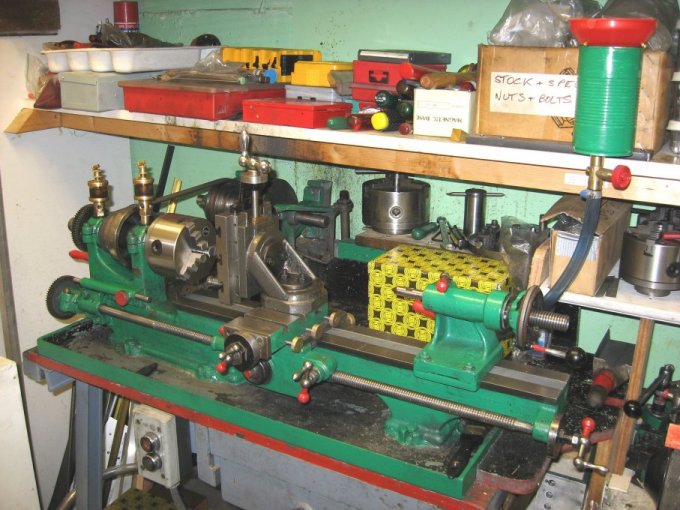
I am also an active Radio Amateur, and some of my radio station equipment is also designed and built by me in my workshop, as well as most of the antennas involved in it's use. I work the H.F. bands (160/80/40/20/15 and 10m) as well as the VHF bands 6m / 50MHz and 2m / 144MHz and UHF bands 70cm / 432MHz and the higher bands 23cm / 1296MHz and 3cm / 10GHz. (The bands in between are currently being built for, i.e. 13cm / 2368MHz, 9cm / 3450MHz, and 6cm / 5800MHz. A picture of my radio station (was G8GFH now PA2TG) gives some idea of it:-

...and an updated [ JUNE2009 ] image with some revision is:-

ATV! SSTV! ATV!
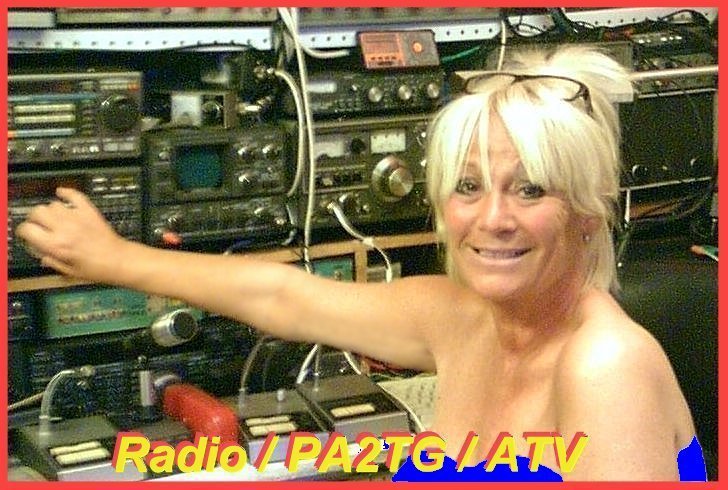 Centrepiece of the main ATV / TV testcard.
Centrepiece of the main ATV / TV testcard.
Image transmission in the form of ATV and SSTV is one of the aspects of communication that interests me, and therefore form part of the radio station. There is now an image update page under this link with current image communication status uplinks. This is in the early stages yet, but will evolve... when I get around to writing the necessary software!
Of course this requiers the use of various antennas, and a couple of views of these can be seen below. Firstly, an overall image of the rotatable Yagi's for 50MHz, 144MHz, 432MHz and 1296MHz, together with, on the right, two vertical omni-directional monitor antennas for 144MHz / VHF and 432MHz / UHF, both broadband. Thw two dish antennas can also be seen, one is for satellite-TV monitoring which mainly checks the functionality of the 1 - 2GHz FM TV receiver and the second, as yet not aligned, is for 3cm (10GHz) band use, including amateur television:-
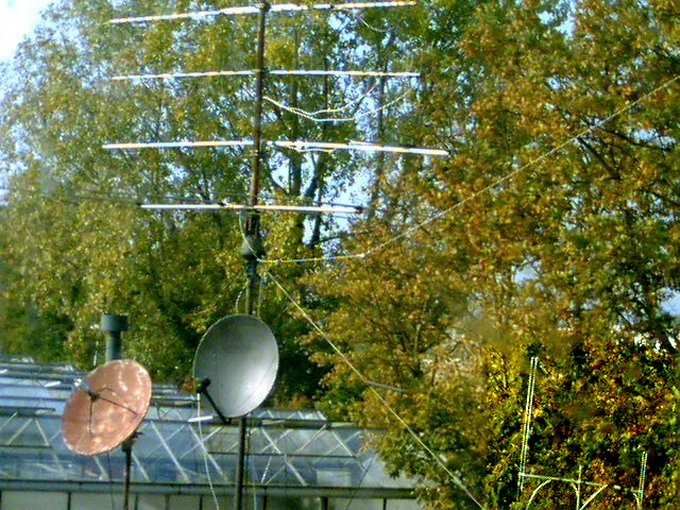
A more close-up view of the rotatable stack is below:-
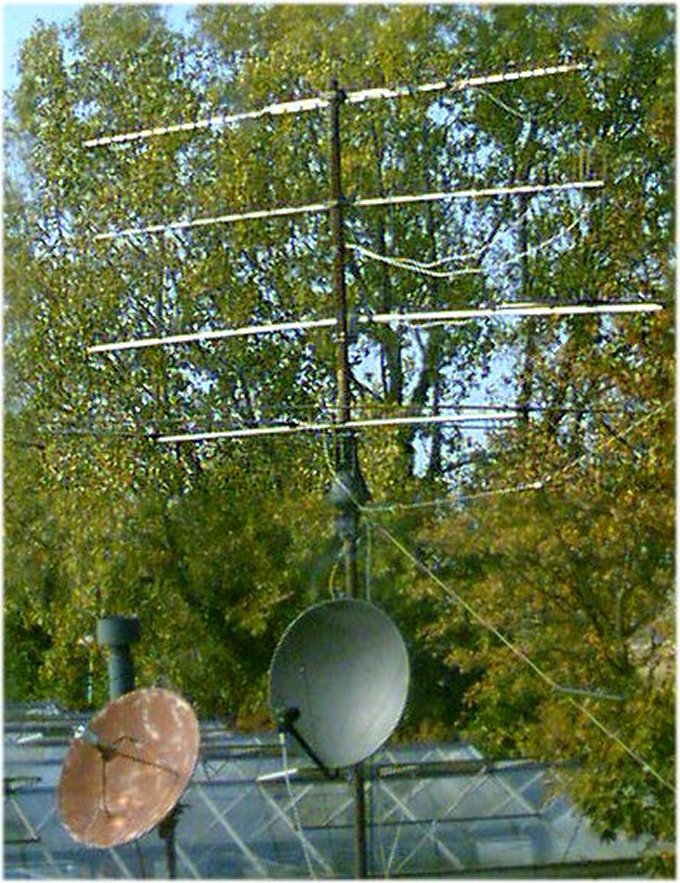
Of course, a lot of my activities, especially the technical ones, require the use of computers, so I have a number of machines - quite a lot, in fact - for software development, for hardware development, for various peripheral control, for my amateur radio station, for Video/Audio production, and for the desktop, administration and archiving requirements; these are all networked via a central network shelf full of equipment as is a computer that makes up the 'intranet' internal server. Here I am at a desktop machine in the computer area:-
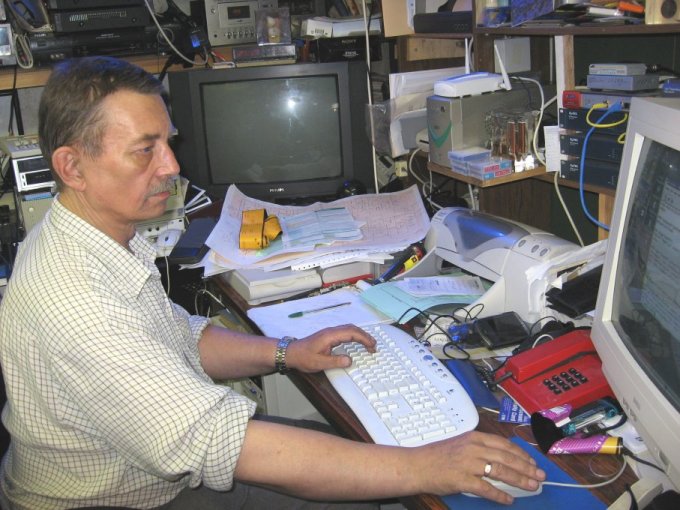
where I use Linux (Fedora Core) for normal desktop use, for the intranet
server machine, for the second backup machine and for one of the software
development machines. I also maintain and admin the network using a Linux
machine as well. Other machines, such as that for chop-programming and
certain hardware control uses microsoft Windows, promarily because there
are no Linux drivers available for their associated peripherals.
An updated handy reference (toung-in-cheek) to all the
insides of a computer, detailed, is available now for amusement 8*). Obviously,
I know nothing about real computers and I deny all knowledge of anything to do with them.
Chips with everything...
If you happen to be interested, involved or work at electronics design, development or repair or simply have it as a hobby, you may be interested in the Chip Directory which is residing with a fellow ISP client: this useful resource can be jumped to by selecting this link. It has an enourmous amount of useful information about many devices, both new and old.
FTP sites...
Various well-known FTP archive sites abound on the Internet, and one of the most useful I have found is the FUNET archive and this can be found by clicking here .
A lot of useful and topical information concering the IT / ICT business can be
found on the Internet, but often by it's very nature out-of-date. One site
which is of good relevance is to be found at
this useful link which gives very useful and timely information to IT people and also anyone else
who is concerned with the state of ICT including the latest legal news and
virus warnings: well-worth checking back to now and again even if you're not
in the IT/ICT field.


You can E-mail the author of these pages
(Trevor Gale) by using this link.
on the Dutch Internet service provider XS4ALL.
